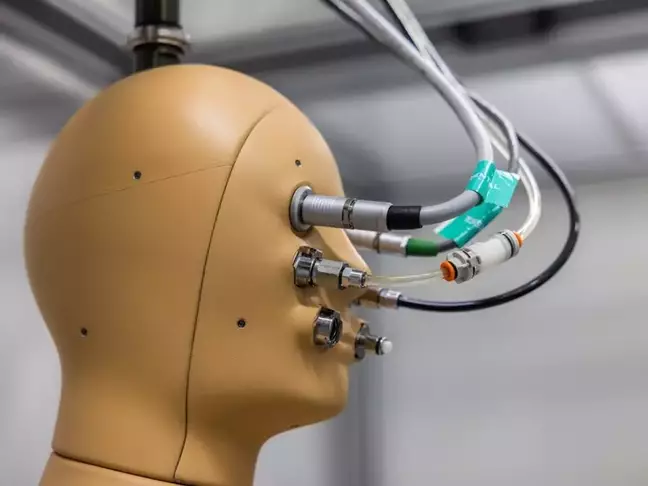Scientists Create Groundbreaking 'Breathing, Sweating, Shivering' Robot
Scientists create groundbreaking 'breathing, sweating, shivering' robot. This groundbreaking development by researchers at Arizona State University (ASU) aims to enhance our understanding of how the human body responds to heatwaves.
Author:Daniel BarrettJun 13, 202328.2K Shares830.9K Views

Scientists create groundbreaking 'breathing, sweating, shivering' robot. This groundbreaking development by researchers at Arizona State University (ASU) aims to enhance our understanding of how the human body responds to heatwaves.
The robot, known as ANDI (Artificial Non-human Digital Intelligence), has been custom-built for ASU by the company Thermetrics, and its creation was made possible through funding from an NSF Major Research Instrumentation Grant.
Unparalleled Mimicry Of Human Functions
ANDI stands out due to its ability to mimic a wide range of human bodily functions.
Equipped with 35 individually controlled surface areas, the high-spec robot incorporates temperature sensors, heat flux sensors, and even pores that generate sweat.
Principal investigator Konrad Rykaczewski emphasizes the significance of ANDI's capabilities, stating that the research project aims to comprehensively understand the impact of heat on the human body and develop quantitative measures to address it.
Unveiling The Mysteries Of Heat Stress
By simulating extreme heat conditions and studying the robot's physiological responses, researchers can gain valuable insights into the effects of heat stress on human health.
Atmospheric scientist Jenni Vanos highlights the importance of this research, explaining that although heat-related deaths are known to occur, a comprehensive understanding of the underlying factors is still lacking.
ANDI's unique abilities provide a means to bridge this knowledge gap and shed light on the complexities of heat-related fatalities.
ANDI's existence serves a crucial purpose, allowing scientists to conduct experiments that would otherwise be unethical or dangerous to perform on humans.
“„MaRTy can tell us how the built environment modifies the amount of heat that hits the body, but MaRTy doesn't know what happens inside the body. MaRTy measures the environment, and then ANDI can then tell us how the body can react.- Ariane Middel, assistant professor in the School of Arts, Media and Engineering
“„We can move different BMI models, different age characteristics and different medical conditions [into ANDI],” said Ankit Joshi, an ASU research scientist leading the modelling work and the lead operator of ANDI.- Ariane Middel, assistant professor in the School of Arts, Media and Engineering
“„A diabetes patient has different thermal regulation from a healthy person. So we can account for all this modification with our customised models.- Ariane Middel, assistant professor in the School of Arts, Media and Engineering
With ANDI, researchers can replicate hazardous heat scenarios and study the intricate details of the body's reactions. This ethical approach enables a deeper understanding of the mechanisms behind extreme heat's potentially fatal consequences.
Collaboration And Future Prospects
ASU's ANDI is not alone in its mission. The university's Tempe Campus project boasts ten identical ANDI manikins globally, several of which are utilized by athletic clothing companies for garment testing.
Additionally, ANDI's potential is set to be further amplified through collaboration with another ASU creation, the biometeorological heat robot named MaRTy.
This joint effort aims to unravel the intricacies of human sweating mechanisms and explore the interplay between environmental factors and bodily responses.
The creation of ANDI represents a significant breakthrough, offering unprecedented insights into the human body's reaction to heatwaves.
As researchers delve deeper into the complexities of heat stress, this pioneering robot opens new avenues for designing strategies to mitigate its impact, ultimately safeguarding human lives in an increasingly warming world.
Final Words
The development of the world's first 'breathing, sweating, shivering' robot, ANDI, by researchers at Arizona State University (ASU), is a groundbreaking achievement.
ANDI's ability to mimic human bodily functions provides valuable insights into the impact of heatwaves on the human body.
This innovative technology offers a safe and controlled environment for studying extreme heat, bridging gaps in our understanding and paving the way for effective strategies to address heat-related risks.
With its collaborations and potential applications, ANDI has the potential to revolutionize research and contribute to protecting human health in the face of climate change.

Daniel Barrett
Author
Daniel Barrett is a tech writer focusing on IoT, gadgets, software, and cryptocurrencies. With a keen interest in emerging technologies, Daniel offers expert analysis and commentary on industry trends. Follow him for authoritative insights into the latest tech innovations.
Latest Articles
Popular Articles